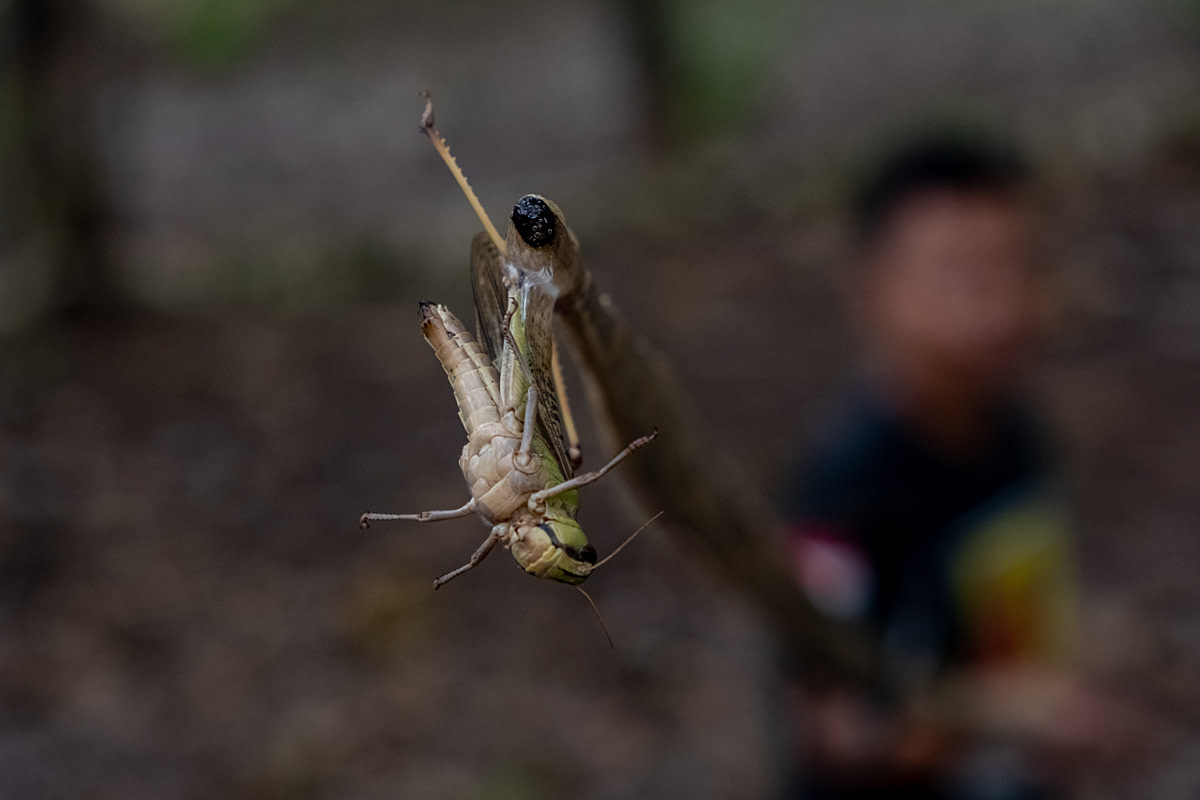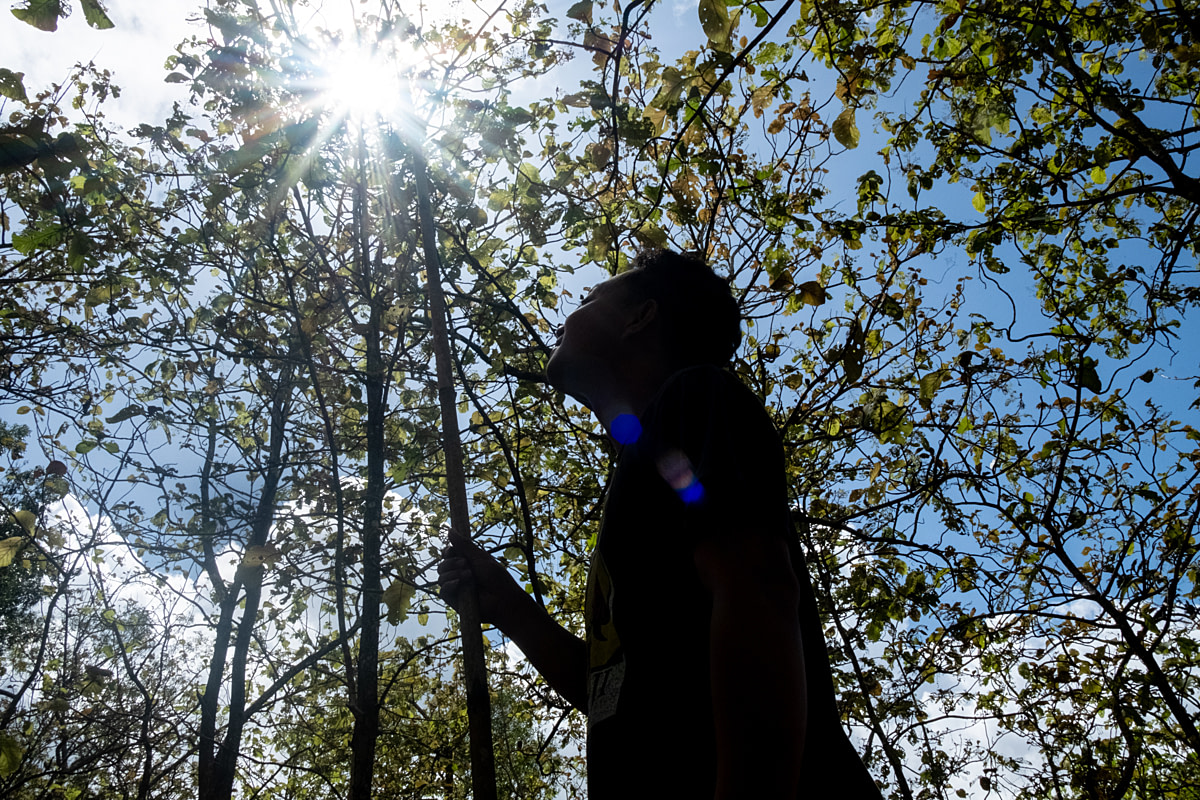Documenting Grasshopper Catching and Cricket Farming in Indonesia
A collector shows dead and alive grasshoppers after being released from a sack at a collector’s house in Wonosari. Indonesia, 2024. Resha Juhari / We Animals Media
Photographer: Resha Juhari
Author: We Animals Media
Explore and download these visuals via our stock platform.
We Animals Media photojournalist Resha Juhari recently explored and documented the practices of grasshopper catching and cricket farming in Indonesia. Consumption of insects in Indonesia stems from ancient times and is becoming increasingly popular among visiting tourists, despite its threat to the country’s precious biodiversity.
“Seeing insects used as food was a different experience for me. This assignment involved aspects of pests, protein foods, ancient traditions, the environment, and the sustainability of the food chain.” ― Resha Juhari, animal photojournalist

Grasshopper Catching for “Walang Goreng”
In the Indonesian district of Wonosari, fried grasshoppers, known as “Walang Goreng,” are a long-standing culinary tradition and are also popular with tourists. Despite being considered pests, grasshoppers play crucial roles in ecosystems, aiding agriculture by consuming unwanted vegetation and decaying plant matter, and enriching the soil with their dung.
Indonesia is the second most biologically diverse country in the world but its ecosystems are degrading at a concerning rate due to land-use change and overexploitation. Excessive human consumption of this insect threatens Indonesia’s already dwindling wildlife population, which relies on grasshoppers as a primary food source. This potentially leads to ecological imbalances and adverse cascading effects on the local environment.

The high teak trees are inhabited by many grasshoppers. Wonosari, Gunung Kidul Regency, Yogyakarta Special Region Province, Indonesia, 2024. Resha Juhari / We Animals Media

A collector reaches into a large sack filled with live wild-caught grasshoppers to remove dead animals and sort them for sale. Wonosari, Gunung Kidul Regency, Yogyakarta, Indonesia, 2024. Resha Juhari / We Animals Media

A wild grasshopper stuck to a hunter’s catching stick is removed by a grasshopper hunter. Grasshopper hunters use glue-coated wooden sticks to make grasshoppers dwelling in teak trees easier to catch. Wonosari, Gunung Kidul Regency, Yogyakarta, Indonesia, 2024. Resha Juhari / We Animals Media

An escaped wild-caught grasshopper sits atop a sack containing countless other live grasshoppers at a collector’s home. Wonosari, Gunung Kidul Regency, Yogyakarta, Indonesia, 2024. Resha Juhari / We Animals Media

Live wild-caught grasshoppers are separated from large sacks into smaller one-kilogram plastic bags by a grasshopper collector. Wonosari, Gunung Kidul Regency, Yogyakarta, Indonesia, 2024. Resha Juhari / We Animals Media
Locals and foreign tourists frequently purchase fried grasshoppers from stalls along the Wonosari Highway, a popular tourist route. One seller, in business for 25 years, attracts customers by preparing the live grasshoppers and frying them on-site.

Fried wild-caught grasshoppers are removed from a pan and transferred to containers at a roadside fried grasshopper stall. Wonosari, Gunung Kidul Regency, Yogyakarta, Indonesia, 2024. Resha Juhari / We Animals Media

A wild grasshopper’s abdomen is cut open with scissors by a roadside fried grasshopper seller who is preparing grasshoppers for cooking. Wonosari, Gunung Kidul Regency, Yogyakarta, Indonesia, 2024. Resha Juhari / We Animals Media

A man purchases fried grasshoppers from a roadside fried grasshopper seller. The sellers set up along the town’s main road, aiming to sell to visiting tourists. Wonosari, Gunung Kidul Regency, Yogyakarta, Indonesia, 2024. Resha Juhari / We Animals Media
Cricket Farming
In Indonesia, the nocturnal chirps of crickets are a familiar sound, and these insects have long been used in Asian regions as ‘fighting” animals or as a food source for farmed animals and humans.
Like many insects, crickets naturally benefit ecosystems by consuming decaying plant and animal matter and enriching the soil with their dung, reducing the need for pesticides. Despite these benefits, the rise in popularity of bird and fish ownership has increased the farming of crickets in Indonesia as a source of pet food.

A single medium-sized cricket sits on the knuckles of a cricket farmer’s hand, who displays the animal to the camera. Wonosari, Gunung Kidul Regency, Yogyakarta, Indonesia, 2024. Resha Juhari / We Animals Media

Crickets dwell at the bottom of a wooden cricket cage at a residential cricket farm while the farmer checks the cassava leaf and chicken pellet feed spread throughout the box. Wonosari, Gunung Kidul Regency, Yogyakarta, Indonesia, 2024. Resha Juhari / We Animals Media

Crickets inside a wooden box live amid their cassava leaf and chicken pellet feed at a cricket farm set up at the farmer’s home. Wonosari, Gunung Kidul Regency, Yogyakarta, Indonesia, 2024. Resha Juhari / We Animals Media
Cricket farming requires little space and typically occurs at people’s homes. The insects are kept in wooden boxes and fed leaves, such as cassava and papaya, or pelleted chicken feed. One of the cricket farmers our photojournalist spoke with harvests 20 to 30 kilograms of crickets every two days and approximately 300 kilograms per month.
After approximately 30 days, when the crickets have grown to a saleable size, they are sold to Javanese regions as animal feed or fried as snacks, a relatively new trend popular with tourists. These snacks are made with live crickets, who are cleaned, seasoned, and then cooked in hot oil.

Farmed crickets crawl over trimmed cassava leaf stems, displayed to the camera by the farmer. The crickets also receive chicken feed pellets to eat. Wonosari, Gunung Kidul Regency, Yogyakarta, Indonesia, 2024. Resha Juhari / We Animals Media

Crickets inside a wooden box live amid their cassava leaf and chicken pellet feed at a cricket farm set up at the farmer’s home. Wonosari, Gunung Kidul Regency, Yogyakarta, Indonesia, 2024. Resha Juhari / We Animals Media

With the farming and consumption of insects rising around the globe as pressure amps up to find solutions to feed our growing population, insect cognition and sentience are being researched and discussed more than ever. These visuals offer a glimpse into the experiences of these previously unconsidered animals.

Images by Resha Juhari.
Explore and download visuals from this assignment via our stock platform and help tell these underreported stories.
Donate today and help us continue to produce compelling global investigations into these underreported stories.
More like this from We Animals Media:
Havva Zorlu’s 2023 Animal Photojournalism Fellowship
by We Animals Media | Feb 16, 2024
Assignment: Inside Indonesia’s Shark Fin and Meat Trade
by We Animals Media | Dec 19, 2022



